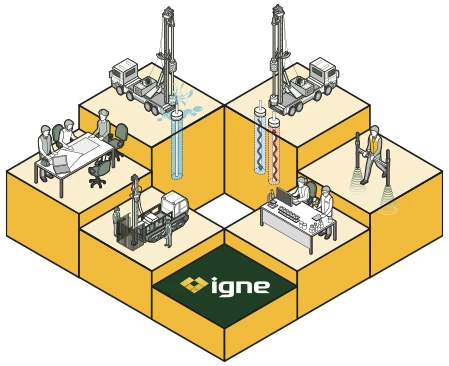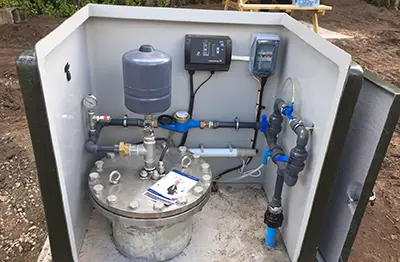

Temperature & Conductivity Logging
Temperature and conductivity logging is a highly effective downhole method used to detect groundwater inflow and outflow zones, assess stratification, and identify anomalies in water chemistry.
About
Logging Temperature & Electrical Conductivity
These logs provide real-time insights into the thermal and electrical properties of the borehole fluid column, helping to identify where water is entering or exiting the borehole, and what quality it might be.
At Igne, we use precision temperature and conductivity probes to deliver accurate borehole data as part of our geophysical logging services. These readings help clients make informed decisions about screen placement, pumping strategy, remediation planning or environmental monitoring.

The measurements
What Does Temperature & Conductivity Logging Measure?
This dual-parameter log records:
- Temperature
Natural variations in temperature with depth can indicate active groundwater movement, vertical flow, or thermal anomalies. - Electrical Conductivity (EC)
This measures the ability of water to conduct electricity, which is strongly influenced by dissolved solids. It provides a proxy for salinity or contamination.
Together, these measurements help identify:
- Groundwater inflow and outflow zones
- Vertical flow within the borehole (especially in ambient conditions)
- Zones of differing water quality or chemistry
- Changes in hydraulic connectivity
- Thermal stratification for geothermal studies
- Potential contamination or saline intrusion
The uses
Common Applications
This logging technique supports a wide variety of projects, including:
- Water well design and screen placement
- Geothermal borehole performance profiling
- Environmental baseline studies and pollution tracking
- Post-remediation groundwater assessment
- Mine water heat recovery schemes
- Monitoring for saline intrusion near coastal areas
- Hydrogeological modelling
The Process
How Temperature & Conductivity Logging Works
The logging tool is slowly lowered through the water column in the borehole. It is left stationary for 30seconds to adjust and gather reliable data. Sensors on the probe measure changes in water temperature and conductivity at fine intervals, creating a continuous vertical profile.
These logs can be taken in ambient conditions (static water level) or during pumping for dynamic analysis.
Where multiple aquifers or stratified water conditions exist, temperature and EC logging helps pinpoint their boundaries.
FAQ
Frequently Asked Questions about Temperature & Conductivity Logging
- Do I need a clean borehole to run these logs?
Ideally yes; clear water and a stable borehole environment provide more reliable data. Cleaning, airlifting or brushing may be recommended before logging if turbidity is high.
- Can these logs identify contamination?
They can indicate changes in water chemistry, including salinity or pollutant intrusion, but are best used in combination with sampling and laboratory testing for confirmation.
- Can you run these logs in a cased borehole?
Yes, as long as the casing is non-metallic (e.g. PVC) and the borehole is filled with water. The tools require direct contact with the fluid column.
- How often should temperature and conductivity logs be repeated?
They can be conducted once during investigation or repeated periodically for monitoring programmes, especially where groundwater movement or quality is expected to change.
- What’s the depth limit for this logging method?
We can log boreholes to several hundred metres depending on access and conditions. We’ll confirm maximum depths during project scoping.
The Next Step
Make Informed Decisions About Your Groundwater System
Temperature and conductivity logging is a powerful tool for understanding water movement and quality, especially when you need to design efficiently or monitor change over time.
Contact Igne today to book a borehole survey and get the data you need to manage groundwater with clarity and confidence.


Temperature & Conductivity Logging

Flowmeter Logging

Caliper Measurement Logging

Dual Focused Resistivity Logging

